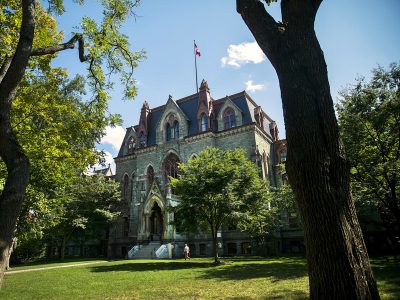It’s a common sight this time of year: Lost freshmen searching for someplace to eat, buy books, learn about a student activity, etc., etc. These days, though, the people they turn to for directions may be just as confused, as a slew of building and renovation projects reshapes the campus. New landmarks are going up and some old favorites are moving — to new locations or into the past.
Those who feel that the area has been turned upside down may be forgiven the exaggeration. The current level of construction activity is unusual. According to Omar Blaik, vice president for facilities management, the University is in the midst of what amounts to a $1 billion capital program. “Nobody is calling it that, but when you add up the numbers,” that’s what it comes to, he says. Expenditures ran to $60-$70 million in 1994-95, rising to about $120 million last year and $130-$140 million this year — a level that will “continue next year and in all likelihood for several years and then start tapering off,” he says.
Last year saw the completion of the Institute for Advanced Science and Technology, but most projects now under way will be finished in the next year or two, says Blaik — and are currently at the peak of construction. The School of Medicine, for example, is building a $150 million, 385,000 square feet state-of-the-art biomedical-research building, which will open next fall.
But unquestionably the highest-profile projects — and the ones with the greatest immediate impact on the campus environment — are Sansom Common, the retail and hotel complex that occupies the block bounded by 36th and 37th Streets and Walnut and Sansom Streets, and the Perelman Quadrangle, which will tie together Logan, Houston, College, and Williams Halls with Irvine Auditorium to create a new undergraduate hub.
The centerpiece of the $120 million Sansom Common project, the new Penn Bookstore, managed by Barnes and Noble, opened for business July 15 — “on schedule,” notes Blaik, though workers were still polishing the brass lamps and unpacking supplies for the second-floor cafe as the first customers streamed in. The store’s 50,000 square feet houses some 130,000 books, plus magazines and newspapers, cards and posters, a section devoted to Penn merchandise, and (of course) a cafe serving Starbucks coffee.
The general layout and furnishings will be familiar to anyone who’s set foot in any Barnes and Noble superstore, but the corporate name is nowhere in evidence. And the wall murals feature University scenes and people rather than caricatures of non-Penn literary lights. Other retail tenants that were scheduled to open for business by the start of classes include an XandO coffee bar and an Urban Outfitters clothing store.
“The hotel portion of the project will be completed by the fall of next year,” says Blaik, and will include a new version of the Faculty Club integrated into the 250-room hotel. Late this summer, workers blasted through a parking garage and brick wall between the two Grad Towers to create a new street from Chestnut to Sansom that will serve as the main entrance to the hotel.
While the bustle around the Bookstore will mask somewhat this year’s continuing construction on Sansom Common, there’s no concealing the scope of work on the other side of College Green. Last spring, Houston Hall closed in the latest phase of the Perelman Quadrangle project, which “includes a complex array of issues dealing with one of our more historic precincts on campus,” in Blaik’s words.
The renovation of Logan Hall was finished last January. Renovation of Irvine Auditorium, closed since last summer, is 30-35 percent done, says Blaik. The project, targeted for completion next fall, will restore the interior decoration, improve acoustics, and create cafes and new rehearsal rooms and performance spaces by closing off the auditorium’s sides, eliminating seats that have a poor view of the stage.
The public space in Williams Hall, the youngest of the structures involved and the “weak link” in the quad concept, says Blaik, is also being renovated to create a 24-hour study space and a cafe and to enhance the connection between Williams and Houston Halls.
The renovation of Houston Hall is designed to restore the ground-floor spaces to something like the original design, with lobbies, a cafe, a reading room, dining room, and study lounge; on the second floor, the meeting rooms and auditorium will be upgraded; student organizations will have space on the third floor; and the building’s internal systems will be upgraded and central air-conditioning installed.
The basement area, says Larry Moneta, associate vice president for business services, will be transformed into a grand march�-style food market — essentially, a single kitchen offering a variety of foods at separate sections, rather than the former lineup of fast-food choices — and will have twice the seating capacity. The basement will also include magazine, card, and other stores, and a game area. Negotiations are under way with some leading purveyors of computer games. “It will be something contemporary,” Moneta promises.
The block of 38th Street between Locust Walk and Walnut Street, former home of the Penn Bookstore and an assortment of other businesses, will become the site of a $120 million Wharton School building, scheduled to begin construction in the summer of 1999. The current structure will be demolished, most likely during the coming winter break, says Blaik.
By the end of the school year, a number of shops had already relocated off-campus. One long-time tenant, University Jewelers, moved to the 3401 Walnut Street building. However, at this writing, no agreement had been reached between the University and another area institution, the Penn Book Center, for a space on campus. The fate of the Book Center and other independent bookstores, such as House of Our Own at 39th and Spruce Streets, became an issue in campus discussions over Barnes and Noble’s management of the new University bookstore.
Another project completed this summer — and also the subject of controversy — was the construction of five “fresh-air food plazas” to accommodate about 50 of the food trucks and carts displaced as a result of a City Council ordinance restricting vending activity on the streets surrounding campus. Passed last spring at the urging of the University [“Gazetteer,” October 1997 and June], the ordinance went into effect on August 10.
A final food-related note: Le Bus, which began selling sandwiches on campus out of a converted school bus in 1978 and expanded to include several indoor restaurants and a commercial bakery operation, abruptly closed its Sansom Street restaurant at the beginning of July. According to reports in The Philadelphia Inquirer and The Summer Pennsylvanian, co-owners Daniel Braverman and Ruth Drye wanted to concentrate on the company’s other ventures, in particular the baking business. The Sansom Street location has been leased to a chain called Soupmasters, which planned to open by the start of the fall semester, offering a similar menu.
Saturday, July 5, 2025
Popular
Administration
Anniversary
Archaeology
Architecture
Art
Awards
Books
Calendar
Campus Life
Commencement
Education
Elsewhere
entrepreneurs
Events
Exhibition
Expert Opinion
Faculty
Film
Football
Gifts
Health
Healthcare
Heard on Campus
History
International
Leadership
Medicine
Men's Basketball
Music
notes
obits
painting
Penn Medicine
Penn Museum
Philadelphia
Photography
Poetry
Politics
Science
Student Life
Technology
Television
Theater
Wharton
Window




